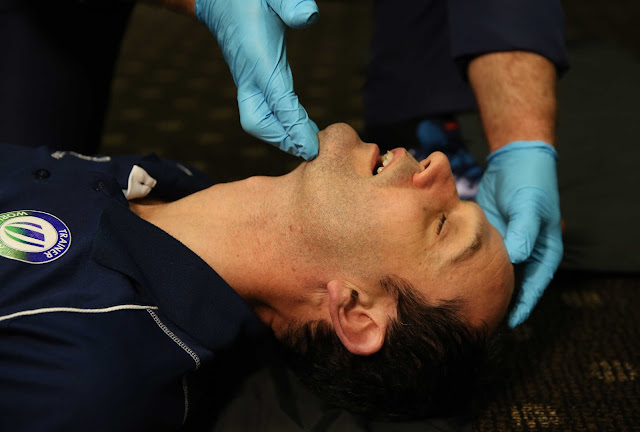In emergencies, knowing how to effectively manage an airway can be the difference between life and death. The head tilt-chin lift maneuver is a fundamental technique used in first aid and resuscitation to open the airway of an unconscious person. This guide will explore when and how to use this crucial technique, emphasizing its importance in various situations.
What is the Head Tilt-Chin Lift Maneuver?
The head tilt-chin lift maneuver is designed to prevent airway obstruction caused by the tongue falling back into the throat. It is particularly effective in unconscious individuals who are not breathing or are breathing inadequately. By tilting the head back and lifting the chin, this technique helps clear the airway, allowing for better airflow to the lungs.
Key Features of the Head Tilt-Chin Lift
Simple Technique: The maneuver is straightforward and can be performed by anyone trained in basic life support (BLS).
Immediate Effectiveness: It can quickly restore airflow in emergencies.
Widely Taught: This technique is a staple in CPR courses and first aid training programs.
When to Use the Head Tilt-Chin Lift
Understanding when to apply the head tilt-chin lift maneuver is crucial for effective airway management. Here are specific scenarios where this technique should be employed:
1. Unconscious Victims
The primary indication for using the head tilt-chin lift is when you encounter an unconscious individual who shows no signs of breathing or has abnormal breathing patterns. This could occur in various situations, such as:
Cardiac arrest
Drowning incidents
Overdose cases
2. Non-Traumatic Situations
The head tilt-chin lift should be used when there is no suspicion of cervical spine injury. If a person has suffered trauma, particularly to the head or neck, alternative methods like the jaw-thrust maneuver should be considered to avoid exacerbating potential injuries.
3. During CPR
Incorporating this maneuver during cardiopulmonary resuscitation (CPR) can significantly improve ventilation effectiveness, especially in cases where rescue breaths are administered alongside chest compressions.
How to Perform the Head Tilt-Chin Lift
Performing the head tilt-chin lift maneuver involves several steps that should be executed carefully:
Step-by-Step Instructions
Assess Responsiveness: Approach the individual and check for responsiveness by gently shaking their shoulders and asking if they are okay.
Call for Help: If unresponsive, call emergency services immediately or ask someone else to do so.
Position the Person: Ensure that the person is lying flat on their back on a firm surface.
Open the Airway:
Place one hand on their forehead and apply gentle pressure backward.
Use your other hand to place your fingers under their chin.
Tilt and Lift:
Gently tilt the head back while simultaneously lifting the chin upward.
Ensure that you do not press on soft tissue below the mandible, as this may obstruct airflow.
Check for Breathing: Observe for chest rise and listen for breath sounds for about 10 seconds.
Provide Rescue Breaths if Necessary: If there is no breathing, proceed with rescue breaths while maintaining the head tilt-chin lift position.
Monitor Continuously: Keep observing for any changes in breathing or responsiveness while waiting for emergency personnel.
Benefits of Using Head Tilt-Chin Lift
The advantages of mastering this technique extend beyond just opening an airway:
Enhanced Survival Rates
Studies indicate that proper airway management significantly increases survival rates in cardiac arrest victims. By ensuring an open airway, rescuers can provide effective ventilation, which is critical during resuscitation efforts.
Versatility Across Age Groups
The head tilt-chin lift maneuver can be applied across all age groups, from infants to adults, making it a versatile skill for both laypersons and healthcare providers.
Foundation for Advanced Techniques
Mastering this basic technique lays a solid foundation for learning more advanced airway management skills, such as using oropharyngeal airways or performing advanced cardiac life support (ACLS).
Potential Risks and Considerations
While beneficial, it's essential to recognize potential risks associated with this technique:
Cervical Spine Injuries
In cases where cervical spine injury is suspected, performing a head tilt may worsen any existing damage. In such scenarios, rescuers should opt for alternative methods like the jaw-thrust maneuver.
Ineffectiveness in Certain Situations
If significant obstruction remains despite performing the head tilt-chin lift, additional interventions may be necessary, including suctioning or using advanced airway devices.
Mastering Airway Management
The head tilt-chin lift maneuver is a vital skill that everyone should learn, especially those involved in healthcare or emergency response roles. By understanding when and how to use this technique effectively, you can play a crucial role in saving lives during emergencies.
If you're interested in enhancing your life-saving skills further, consider enrolling in a CPR certification course today! At CPR Tampa, an American Heart Association training site, we offer initial and recertification courses in BLS for Healthcare Providers, ACLS, PALS, and CPR and First Aid. Our classes are designed to be stress-free and hands-on—ensuring you receive the best training possible while gaining confidence in your skills. Don't wait; secure your spot today and be prepared to make a difference!

Comments
Post a Comment